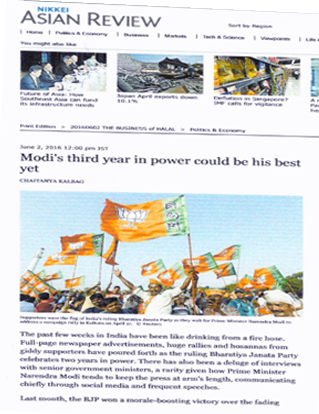Modi’s third year in power could be his best yet
Published date: 2nd Jun 2016, Nikkie Asia Review
View PDFThe past few weeks in India have been like drinking from a fire hose. Full-page newspaper advertisements, huge rallies and hosannas from giddy supporters have poured forth as the ruling Bhartiya Janata Party celebrates two years in power. There has also been a deluge of interviews You might also like with senior government ministers, a rarity given how Prime Minister Narendra Modi tends to keep the press at arm’s length, communicating from China, finance minister Jaitley says chiefly through social media and frequent speeches.
Last month, the BJP won a morale-boosting victory over the fading Indian National Congress party in the northeastern state of Assam, papering over a poor showing in four other provincial polls. The government is basking in the glow of India’s status as the world’s fastest-growing economy; GDP growth in fiscal 2015, which ended in March, was 7.6%. The previous year, too, India’s 7.2% growth outpaced China’s 6.9%. Modi boasts that he has put the “I” at the top of the BRICS grouping of countries.
There is no question that Modi’s government is far more purposeful than its predecessor. In its last few years in power, Congress and the coalition it led were mired in corruption scandals, policy logjams and hubris. But Modi did not inherit a crippled economy. GDP grew an average of 7.5% during the Congress decade, despite a sharp slowdown between 2011 and 2013. Growth had begun to pick up in Congress’s last year: GDP grew 6.9% in 2013-14.
TWO VIEWS Modi claims that when he took over, everybody wanted him to unveil “big bang” economic reforms but that nobody could tell him what exactly that term meant. But while he claims that he wants to “reform to transform,” his critics say he has not moved fast enough. Which view is right?
Most visibly, the Modi government has cracked down on corruption, speeded up decision-making, ended a diesel subsidy and set up more than 219 million bank accounts for the poor for the direct transfer of benefits. It has also continued the Congress party’s massive rural employment guarantee scheme and is strengthening the food and education welfare measures introduced by the former ruling party. Modi also embraced Congress’s Aadhaar program under which more than 1 billion Indians now have a unique identification number that is linked to everything from cooking-gas connections to ration cards.
The truth is that economic reform has spread slowly but incrementally across India. A Congress government launched the economic liberalization of 1991. The BJP has ruled India for a third of the quarter-century since then, and no major reform has been reversed.
The results are significant. The World Bank notes that between 1994 and 2012 the share of India’s population living in poverty halved from 45% to 22%. In 2005, a year after the Congress-led United Progressive Alliance defeated a BJP-led coalition, 37% of Indians were poor, showing there had been good progress. Worryingly, though, about half of Indians continue to be vulnerable, precariously balanced between poverty and the “relative stability of the middle class.”
Poverty’s toll is telling. Modi’s Swachh Bharat (Clean India) campaign aims to end open defecation, but according to U.N. data, about 600 million Indians still do not have toilets. Or take rural electrification. Modi vowed to bring power to 18,542 villages without it (about 3% of India’s total villages), by 2018. However, roughly 300 million Indians, or nearly one-fourth of the population, are still too poor to buy electricity.
Modi, who heads the first single-party government since 1984, has arguably the strongest mandate for change in recent history. But he has failed to build a political consensus that would get his biggest pending reform, a goods and services tax, through parliament.
Among several positives, however, a bankruptcy code has been enacted, and state governments are being encouraged to amend stifling labor laws that discourage any layoffs. India has climbed four notches to 130 out of 189 countries in the World Bank’s Ease of Doing Business ranking. Foreign direct investment ceilings have been raised in 15 sectors, including defense production, insurance and construction. FDI inflows have shown a healthy increase in 2015-16.






